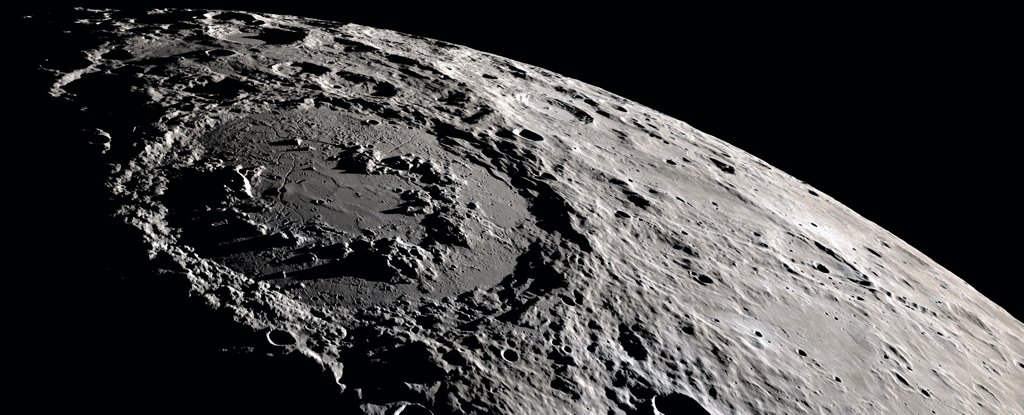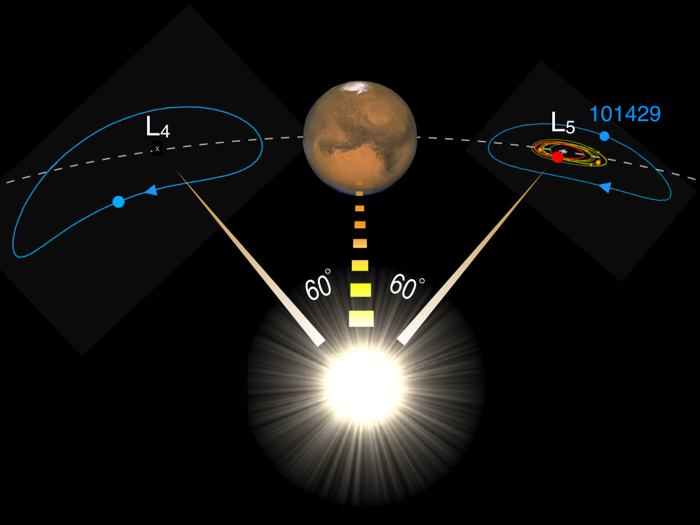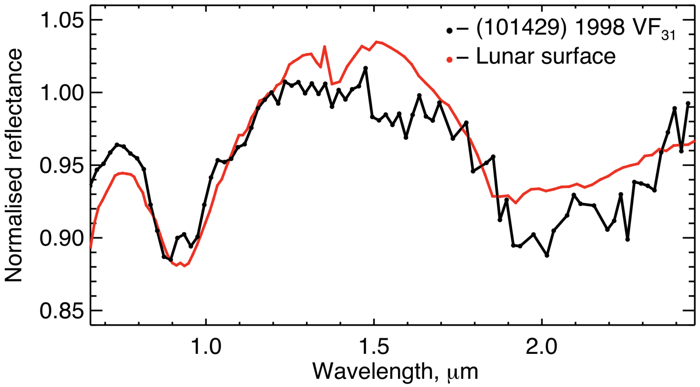
Posted on 11/04/2020 9:13:00 AM PST by Red Badger

The South Pole of the Moon. (NASA GSFC Scientific Visualisation Studio)
===========================================================================
A distant asteroid trailing in the gravitational wake of Mars has been observed in greater detail than ever before, and the close-up reveals a surprising resemblance – one that raises some interesting questions about the object's ancient origins.
The asteroid in question, called (101429) 1998 VF31, is part of a group of trojan asteroids sharing the orbit of Mars.
Trojans are celestial bodies that fall into gravitationally balanced regions of space in the vicinity of other planets, located 60 degrees in front of and behind the planet.
Most of the trojan asteroids we know about share Jupiter's orbit, but other planets have them too, including Mars and Earth too.
What makes (101429) 1998 VF31 (hereafter '101429') interesting is that among the Red Planet's trailing trojans (the ones that follow behind Mars as it orbits the Sun), 101429 appears to be unique.

Depiction of Mars and trojans; 101429 is the blue point circling L5. (AOP)
======================================================================
The rest of the group, called the L5 Martian Trojans, all belong to what's known as the Eureka family, consisting of 5261 Eureka – the first Mars trojan discovered – and a bunch of small fragments believed to have come loose from their parent space rock.
101429 is different, though, and in a new study led by astronomers from the Armagh Observatory and Planetarium (AOP) in Northern Ireland, researchers wanted to examine why.
Using a spectrograph called X-SHOOTER on the European Southern Observatory's 8-m Very Large Telescope (VLT) in Chile, the team examined how sunlight reflects off 101429 and its L5 kin in the Eureka family. Only, it looks like 101429 and the Eureka clan aren't kin after all, with the analysis revealing 101429 shows a spectral match for a satellite much closer to home.
"The spectrum of this particular asteroid seems to be almost a dead-ringer for parts of the Moon where there is exposed bedrock such as crater interiors and mountains," explains AOP astrochemist Galin Borisov.
While we can't be sure yet why that is, the researchers say it's plausible that this Martian trojan's origins began somewhere far removed from the Red Planet, with 101429 representing a "relic fragment of the Moon's original solid crust".
If that's true, how did the Moon's long-lost twin end up as a trojan bound together with Mars?

Spectral comparison of 101429 and the Moon's surface. (AOP)
===============================================================================
"The early Solar System was very different from the place we see today," explains lead author of the study, AOP astronomer Apostolos Christou.
"The space between the newly-formed planets was full of debris and collisions were commonplace. Large asteroids [planetesimals] were constantly hitting the Moon and the other planets. A shard from such a collision could have reached the orbit of Mars when the planet was still forming and was trapped in its Trojan clouds."
It's a captivating idea, but the researchers say it's not the only explanation for 101429's past. It's also possible, and perhaps more likely, that the trojan instead represents a fragment of Mars chipped off by a similar kind of incident impacting the Red Planet; or it might just be a commonplace asteroid that, through the weathering processes of solar radiation, ended up looking just like the Moon.
Further observations with even more powerful spectrographs might be able to shed more light on this question of space parentage, as could a future spacecraft visit, the team says, "which could, en route to the Trojans, obtain spectra at Mars or the Moon for direct comparison with the asteroid data".
The findings are reported in Icarus:
https://www.sciencedirect.com/science/article/abs/pii/S0019103520303602?via%3Dihub
Are you telling us that there are Democrats in space also?
intersting
Or God says “screw it all. It was not best in the lab so restart time.”
The Stolen Twin of Our Moon.
It sounds like a Sci-Fi novel.
Lots of Parallel Universe scenes.

Unlike the Earth, Mars has no inner dynamo to create a major global magnetic field. This, however, does not mean that Mars does not have a magnetosphere; simply that it is less extensive than that of the Earth. ................
The rest of the 'lunar origin' keyword, chrono:
Right but could a moon help create that inner dynamo on Mars?
mark
Gives a whole new meaning to “mooning” somebody.
I doubt it since Mars is geologically dead for the most part, no liquid magma, rich in iron, no magnetic field.
Our Moon has no magnetic field of any consequence...............
“The Attack of the Martian Trojans.”
A liquid center only works if there is enough iron. But isn't Mars red because of iron oxide?
The gravitational tug and pull, would allow iron to work it's weigh to the center of the planet to become part of the molten core and eventually spin would generated the needed magnetosphere.
Of course, I'm still a fan of increasing the Mass of Mars to retain an atmosphere. And since we recently converted light to matter. I think it's only time until we invent the Massinator.
Make Mars give it back!
V.A. Firsoff (Valdemar Axel Firsoff, as it turns out), Strange World of the Moon , published 1959, ten years before the manned landings started, and even before the first robotic landers, is interesting in that it shows the prevailing ideas about what would be found on the Moon (it was already believed during the 19th century, and more relevantly, by the 1920s and 1930s in Germany, that humans would visit the Moon). In a chapter "The Earth's Fair Child or a Foundling?" discusses the concept of the birth of the Moon via an overspin (doesn't use that word) condition on the Earth, which appears to be his view....the Moon clearly could not have been the satellite of the Earth then, for a total period of about 2,000 million years... Spurr points out that the face of the Moon shows two systems of great surface fractures, or faults, lying about 30 degrees from the two poles and trending from west-south-west to east-north-east. This is explained by him as a result of the halting of the Moon's rotation... Curiously, the face of the Earth, too, shows a similar structure, with the same general trend -- the Highland Boundary Fault... The poles of the Earth would also seem to have shifted place on at least three occasions, in the Cambrian, Permian, and (lastly) Quaternary Periods, brining ice and cold to previously warm lands... some mighty force made the crust of the Earth slip (the rotational stability of the axis of a mass as large as the Earth is enormous) and the position of the poles wobbled... there exists on the Moon a triple grid of surface fractures... perpendicular to each other within each grid, the grids being of different ages... Cambrian, Perm-Carboniferous, and Tertiary.Fascinating idea, based though it is on outmoded ideas about impact (i.e., Firsoff's view that there was no role for impact). He's basically given us a snapshot of the problems inherent with a fission origin (either by overspin or by impact), not least of which is that the fission origin also requires in orbit formation of the lunar sphere and capture by the Earth, while showing that capture is possible. He appears to envisage three encounters between the formed Moon and the Earth, resulting in temporary capture twice leading to the eventual outright capture.
Disclaimer: Opinions posted on Free Republic are those of the individual posters and do not necessarily represent the opinion of Free Republic or its management. All materials posted herein are protected by copyright law and the exemption for fair use of copyrighted works.